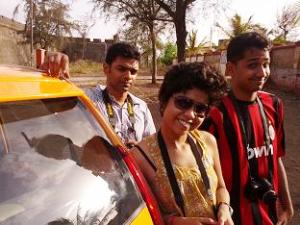The unbinding of middle-class Indian women happened, almost parallel with my own career as a woman journalist. It did not happen overnight. Nor did it happen with dramatic force. The unbinding was a slow almost unnoticed process whose impact built up over two generations. In a way I was privileged. Even as I lived through these times myself as a woman, as a journalist I was also able to document the milestones and watch the horizons waver.
This is from the prologue to my book “Unbound: indianwomen@work”.
The genesis of “Unbound” is a story in itself. After writing “Disappearing Daughters: the tragedy of female foeticide”, I was in a state of depression. I found it hard to accept that daughters were so unwanted in a society which is actually supposed to venerate its women.
As a woman journalist I had over the years documented the lives of many women from a large cross section of society. I knew how much they could achieve and what a vital role they played in preserving the sanity and well being of our society.
So why in such a society were daughters unwanted? The answer was quite simple. They were unwanted because they were considered economic burdens…which was in itself difficult to understand as we actually worshiped Lakshmi the goddess of wealth, who was a woman.
But our society paid only lip service to Lakshmi. Our daughters were perceived only as dependents, dowry burdens and weak human beings in need of protection. It seemed as if they had no other identity.
That’s when I got this slightly quirky idea. Why not I talk to the real Lakshmis of our society? The women who actually generated wealth. Maybe that would help prove that women were not economic burdens and that were actually the providers and nurturers, without whom society could not exist. I went in quest of women who were doing really well in their professions and who were often the pillars of financial, social and emotional support for their families.
But, before I started my journey I wrote a piece which ultimately became the Epilogue:
Once upon a time, Laxmi the Hindu Goddess of Wealth roamed Heaven and Earth, taking a proactive role in the lives of her huge human family. But that was in myth.
In reality she was consigned to a framed picture on the wall. Bejewelled and impassive she remained stuck on her mandatory red lotus in the middle of a ripple-free pond with gold coins emanating from her hand.
For a majority of people across the Indian subcontinent this calendar art Lakshmi symbolized all womankind. Immobilized with lotuses stuck in her free hands and pouring money which she had not generated and over which she had no control, she was no threat to the patriarchal structure of wealth generation which had evolved over the years.
But, just as it began to look like Laxmi would remain stuck forever on her red lotus, something happened. Her unnaturally tranquil pond acquired ripples and then waves which grew higher and higher until they practically swept her off her feet.
And so it was that she left her pond behind and stepped into the real world.
Today, laptop toting, cell phone wielding new age Laxmis stride across the subcontinent and beyond. Very real women holding their own in a very real world.
Today’s working woman is neither a bejeweled symbol nor a commodity of trade. She is the maker of her own destiny.
A power to reckon with.
And, amazingly once this got written, my book took on a life of its own.
I started off by interviewing women professionals mostly in the 25 to 50 age group. These were career women who were in their jobs for the long haul. They earned well, they juggled their lives and chartered their own courses. They lived in big cities across the country and had varied personal and professional backgrounds. They were software engineers, item girls, journalists, chefs, entrepreneurs, teachers, lawyers, doctors, actors, salesgirls, hairdressers.
What emerged after one year of travel and research was an amazing story of the lives of these women living in modern India and creating their own work spaces. They spoke about everything from managing marriage and motherhood to sexuality and sexual harassment at the workplace to ambition and the lack of it and finding footholds in the macho workspace. I was also able to trace a female pattern of achievement which was very different from the male one and a female method of work-life management which was so much more practical than the one the men used.
Almost all the very real women who feature in this book gave me permission to use their real names. So with the exception of one or two women who wished to remain anonymous for obvious reasons all the women spoke out freely and thoughtfully on their lives.
Most importantly, to me as an author, Unbound touched the hearts of working women across the country .
I end this piece with some more excerpts from my prologue.
….Once upon a time, not so long ago, to the Indian middle class woman her home was her world and her family her life. It was a simple world where men went out and earned money while women stayed at home and raised families.
In this cozy, boxed in world, men did the economically productive and socially valued “outside” jobs and women did the non-paying and devalued “inside” ones. Education was a male prerogative. Workplaces were macho areas where no woman dared to go. The walls were strong and rigid. The delineations unquestionable.
Were the women happy with this world and with these rules? No one bothered to ask. Because it worked. Or at least it did for the men.
About a hundred years ago, in many middle class families across the country, girls were married off before they attained puberty. They became mothers several times over before they reached their twenties. The Sharada Act which was passed in 1930 prohibited child marriage and fixed 18 as the legally permissible age for a girl to get married. Yet, since it was a socially acceptable practice even educated middle class families continued to get their adolescent children married. Men were married early too, but they continued to study and go on to work. Marriage and motherhood totally altered the lives of women. Marriage and fatherhood were incidental to the lives of men…..
……..By the 1970s, women professionals were beginning to appear all over the white collar landscape. And that’s when they realized that all was not hunky-dory.
There were women’s jobs and men’s jobs. A woman could aspire to become an air-hostess, but not a pilot. She could become a sub-editor, but not a reporter. Jobs like policing or even delivering the post were actually closed to women. Whenever a male candidate was available for the same job, he was preferred. Besides, many jobs required women to remain unmarried. Even if they got married they could get sacked when they got pregnant. They were always made to feel apologetic about being women. The old rules were still valid. Marriage and Motherhood continued to alter the lives of women……
…….Jobs which were open to women were actually the most gender unfriendly. When the police force needed women, it laid down a rule that they could not marry. Women school teachers and stenographers had to fight for maternity leave. Women bank clerks were by-passed for promotions and were not even considered for challenging jobs which could help them further their careers.
It took several years of agitation, litigation and gender sensitization to tackle these very basic issues. But the women who entered the job market in the 1970s were not only better educated, they were also more aware of their rights. The new breed of professional women realized that there were several other related gender issues at the workplace which had not been addressed.
Joint families had disintegrated and young mothers had no place to leave their babies when they went to work. If they took extra leave they could get sacked or by-passed for promotion.
Maternity leave became a bone of contention. Laws were passed to ensure women got time off to bear babies, but employers grumbled. And male colleagues felt that the women were exploiting the situation and getting a lot of free time off.
Education and an ability to earn did not free women from social discrimination. Working women still had to pay dowry. They had no control over their own pay packets. While male colleagues relaxed with friends and spent money on themselves, women wage earners had to rush back home to take care of the family. Even the earnings of unmarried women were confiscated by their families and often saved up to pay dowries.
Sexual harassment in the workplace was not even acknowledged as an issue in the early days when women who dressed well to go to work were labeled as “asking for it”. No one, for example, even thought of questioning the pressure tactics used by male bosses on women, forcing them to trade sexual favours for promotions or even for just staying in their jobs…..
…….By the late 1990s, new avenues of employment had opened up to women in a very big way. These new jobs were neither “traditional jobs” nor “traditional male bastions”. They were totally new jobs which were the spin-off of new technology. Call Centres, Software companies, Biotechnology, New Age media ...The opportunities were literally mind-boggling. Gender parity was taken for granted.
Since the companies which offered these jobs were more gender aware women rose fast in their professions. They earned more, travelled more and were more stressed out than they ever were before.
The education and freeing of middle-class women had had a trickle down effect. Even working class families were getting their daughters educated and many of these young women now entered the job market. They brought home pay packets which completely transformed the life style of the family.
By early 2000, the milestones I had documented were important only because they marked the route through which the women had marched out. But they were irrelevant to the new age women struggling to create their own spaces in a world which was expanding by the day. In this book I have attempted to document and salute the pioneering efforts of these new age working women even while I try to look at some of the milestones which resulted in their unbinding….
Find us on facebook: facebook.com/TheThumbPrintMag







































